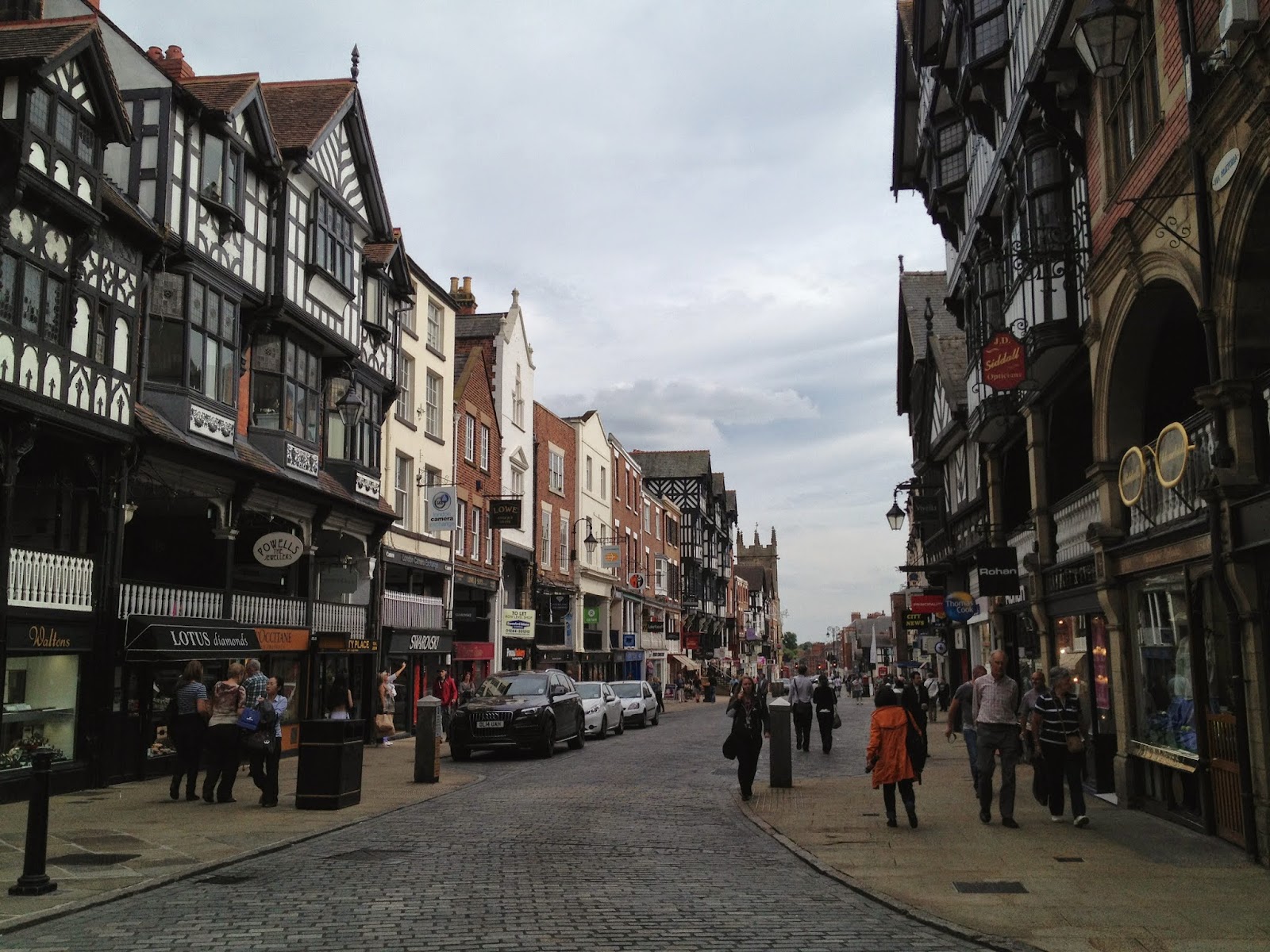Chester: Home of the "Rows" and Eastgate Clock
After a superb lunch at "The Wizard of Edge" we were Chester-bound. This city, like York, has quite a history and it still maintains it's historic architecture. It's a beautiful city to explore and a delight for your eyes! I did a bit of historical research on wikipedia, and I must confess, I was really impressed with what I uncovered!
Town center
In 79 AD, the Romans founded Chester as a castrum (Roman Fort), which they named "Deva Victrix." Although Chester does not exhibit much of it's Roman past, the main intersection of the city --- where Eastgate, Westgate, Northgate, and Southgate come together --- are based upon routes laid out by the Romans nearly 2,000 years ago! When Roman presence in "Britannia" increased, Deva (Chester) became a major settlement.
Fast forward. It is thought that King Arthur supposedly fought his ninth battle in the city of Chester. (Perhaps with his Knights of the Round Table? ;D) Later, St. Augustine may have come to the city in an attempt to unite the church and hold his synod with the Welsh Bishops. (Chester is very close to Wales). Later, in 616 AD, the Anglo-Saxons established themselves in Chester after the Battle of Chester, where the Welsh army was defeated.
I could continue to paraphrase wikipedia, but I won't, since there is a lot of history. If you are however interested in learning more about Chester, please feel free to click here.
Walking around the city
Chester is known for it's "Rows." The Chester Rows are covered walkways that consist of shops sitting on top of other shops --- basically. You can enter these stores at ground level or climb up a few steps to see what's on offer on the second floor. The Rows are located on Northgate, Eastgate, Southgate, and Westgate, and they are totally unique to Chester; nothing like this exists anywhere else in the world (according to Wikipedia).
The Rows date back to medieval Chester and are thought to have been built on top of the ruins of Chester's Roman past, though this is still subject to speculation. Whilst the Rows are not as extensive as they once were and have been blocked by new modern buildings or enclosures, they are still an impressive site and they dominate the Chester skyline. For more about the Chester Rows, click here.
An example of some of the "Chester Rows"
You can see here, the stairs leading up to the second floor of this building
Some of you may be wondering why so many of the buildings are painted black and white. If you have been following my blog, you may have also noticed this in York. Well, I have an explanation for you! I asked our chauffeur that very question and he explained to me that the black and white color scheme dates back to the Victorians. Apparently, the Victorians thought that the bricks, which the Tudors used to build their building, were rather unfashionable, so they painted them white! The black is from the Tudors, but the white is from the Victorians.
I laughed when I saw that this building was the site of a former "confectioner's shop" and was approved by Her Majesty Queen Victoria. (The Queen had a major sweet tooth).
You can really see the contrast of what the Tudors would have seen vs. what the Victorians preferred
Chester, like York, is really a beautiful and charming medieval city. It's not too big, so it's easy to get around, but there is still a lot to see. We were only there for an evening, and we wish we could've stayed longer, but we made the most of our time there and did a lot of exploring! My one con about Chester is that everything closes so early! We arrived at around 4 pm, by the time we started exploring is was around 4:30, but everything (and I mean EVERYTHING) closed at around 5 or 5:30. My mother was desperate for a cup of tea, but everywhere we looked (cafes and tea rooms) was closed. We were so desperate, we were even willing to be bad tourists and go to Starbucks, but much to our shock, even Starbucks was CLOSED! Can you believe it?!
The "Central Perk" from the sitcom Friends is alive and well in Chester!
(But it was in the process of closing, as we walked by)
So much to see and do!
What a beautiful city
Some people don't like the mixture of architectural styles, but I like it. I think it's a reminder of Chester's past, present, and future.
I think this is the main municipal building
City crest
We walked past Chester Cathedral
Chester Cathedral, like most of Chester, has a long history that includes the Romans, the Vikings, the Normans, and many more groups. It is thought that a prehistoric Druid temple existed on the site originally, but was then replaced by a Roman temple dedicated to Apollo. When Christianity came into the picture (approx. 4th Century AD), the "pagan temple" was converted into a Christian church. In 875 AD, the relics of St. Wernburgh were brought to Chester for safekeeping against Viking attacks.
In 1092, the Normal Earl of Chester, Hugh Lupus (nephew of William the Conquerer), made the decision to build a great monastery in Chester. Although construction of this monastery began in the 11th century with Lupus, over the years, the monastery underwent many renovations, the last of which dates to the 16th century!
Unfortunately, with the dissolution of the monasteries under King Henry VIII, monasterial construction ceased, however, the monastery was not destroyed. Rather out of character, Henry converted the cathedral to Church of England, and the last Abbot of the cathedral became the first Dean of the Cathedral in the Diocese of Chester.
I was walking on top of the city wall and walked behind the Cathedral
We saw a lot in Chester, but I think one of the most impressive sites is the Eastgate Clock. The clock sits on the site of the original entrance to the Roman fort of Deva Victrix. It is said to be the second most photographed clock in England, after Big Ben, and frankly, I believe it! It's really really really gorgeous. After going through my photographs and my parent's photographs, between the three of us, we had about a dozen pictures of this clock! The clock was a gift to celebrate the Diamond Jubilee of Queen Victoria and was designed by Chester architect, John Douglas. For more on the Eastgate Clock, click here.
The absolutely gorgeous Eastgate clock




















Incorporating unique wall clocks into your home décor is an excellent way to add both functionality and style. These clocks serve as eye-catching statement pieces that can instantly elevate the look of any room. Whether you're going for a modern, vintage, or quirky theme, unique wall clocks come in a variety of designs to suit your personal taste. They not only help keep you on schedule but also act as decorative focal points that tie the room together. A well-chosen wall clock can transform a plain wall into a creative, conversation-starting feature in your home.
ReplyDelete